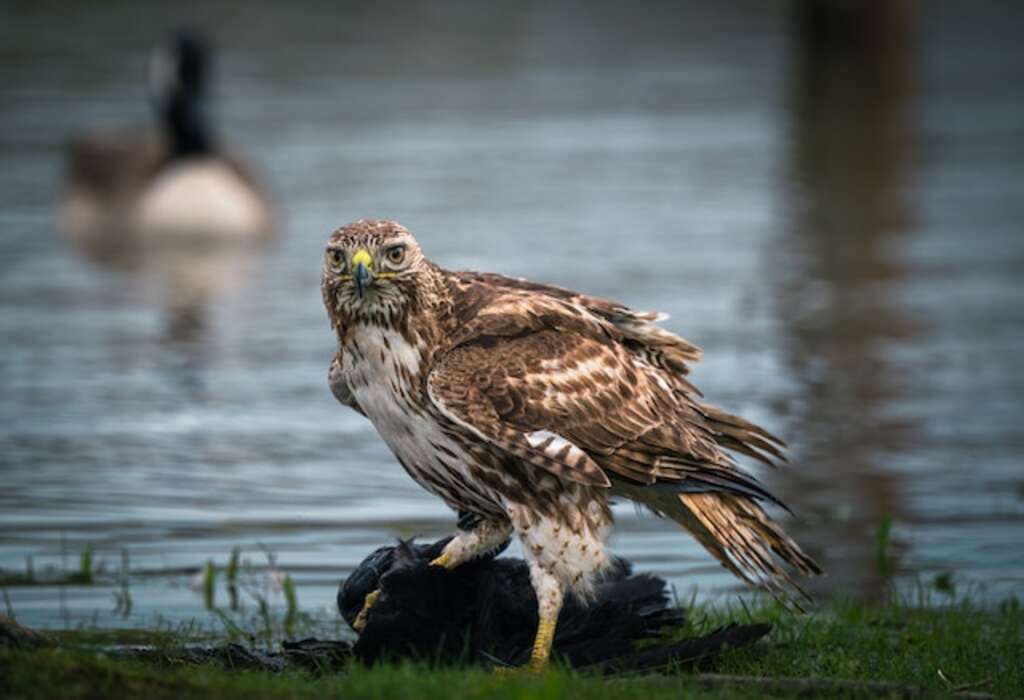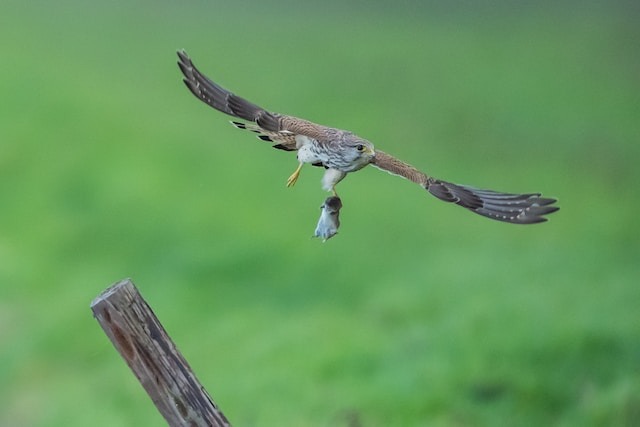Do Hawks Digest Bones? Picture this: a hawk chomping down on its prey, bones and all. These fascinating birds of prey have sharp talons, powerful beaks, and keen eyesight. But what about their bone digestion abilities?
In this captivating article, we’ll explore the secrets of a hawk’s unique digestive system. Discover how hawks extract nutrients from bones, the benefits and risks involved, and compare their abilities to other birds of prey.
Get ready for a feathered adventure that will leave you hungry for more!
Table of Contents
- 1 Key Takeaways
- 2 Do Hawks Digest Bones?
- 3 Overview of Hawks as Birds of Prey
- 4 The Anatomy of a Hawk’s Digestive System
- 5 The Process of Breaking Down Bones
- 6 Extracting Nutrients from Bones
- 7 Benefits of Bone Digestion for Hawks
- 8 Comparison to Other Birds of Prey
- 9 Potential Risks of Bone Digestion
- 10 The Importance of Hawks in Ecosystems
- 11 Conclusion and Future Research Directions
- 12 Frequently Asked Questions
- 12.1 What other animals besides hawks are capable of digesting bones?
- 12.2 How long does it take for a hawk to completely digest a bone?
- 12.3 Can hawks digest bones from all types of animals, or are there certain bones that are more difficult for them to break down?
- 12.4 Are there any negative effects on a hawk’s health if it consumes too many bones?
- 12.5 How does the process of bone digestion differ between hawks and other birds of prey?
- 13 Author
Key Takeaways
- Hawks have a unique digestive system that allows them to partially digest bones, which provide essential nutrients such as calcium and collagen.
- The process of breaking down bones begins in the gizzard, where muscular contractions grind the bones into smaller pieces, then the bone fragments move to the proventriculus, where they are soaked in acidic digestive juices that break down the calcium phosphate matrix of the bones.
- Bone digestion provides significant nutritional value, allowing hawks to extract calcium for bone growth, maintain strong beaks and talons, and obtain essential amino acids.
- The hard and sharp edges of bones can cause potential complications, leading to internal injuries and infections.

Do Hawks Digest Bones?
Hawks have a specialized digestive system that enables them to partially digest bones, which provides them with important nutrients like calcium and collagen.
This ability allows them to extract more nutrients from their prey, making their diet more efficient. While the process may not completely dissolve the bones, it breaks them down enough to access the nutrients inside.
This adaptation is also seen in other birds of prey, such as eagles and owls, and reflects their evolutionary history as carnivorous hunters.
The acidity of their stomach combined with the presence of digestive enzymes breaks down the bones and makes them digestible. The undigested parts of the bones are then regurgitated in the form of pellets.
Overview of Hawks as Birds of Prey
Hawks are classified as birds of prey, or raptors, and are known for their sharp talons, hooked beaks, and exceptional hunting abilities.
Their behavioral patterns and hunting techniques vary depending on the species, but they are all efficient hunters with keen eyesight and a powerful flight.
Hawks are diurnal hunters, meaning they hunt during the day, and rely on their exceptional vision to spot prey from high above.
Once they spot their prey, they dive down at incredibly high speeds and use their sharp talons to capture it.
The anatomy of a hawk’s digestive system is unique and allows them to digest their prey quickly and efficiently.
The Anatomy of a Hawk’s Digestive System
The avian digestive system is composed of various organs that work together to break down food into usable nutrients, with the gizzard being capable of grinding up to 80% of ingested material.
Hawks, as birds of prey, have a unique digestive system that allows them to consume and digest bones.
The anatomy of a hawk’s digestive system includes a muscular gizzard, which has a hard lining that grinds food, and a crop, which stores food before it enters the stomach.
The stomach of a hawk produces strong digestive enzymes that break down proteins, fats, and other nutrients.
The bone structure of a hawk’s prey is also broken down in the stomach, where the acidic environment dissolves the calcium in the bones.
As a result, hawks are capable of digesting bones, which provide essential nutrients such as calcium and collagen.
This process of breaking down bones is crucial for hawks to obtain the necessary nutrients from their prey, allowing them to thrive in their natural habitat.

The Process of Breaking Down Bones
One of the most fascinating aspects of avian digestive systems is their ability to break down even the toughest of materials, such as the bones of their prey.
The process of bone decomposition begins in the gizzard, where muscular contractions grind the bones into smaller pieces.
These bone fragments then move to the proventriculus, where they are soaked in acidic digestive juices that break down the calcium phosphate matrix of the bones.
The remaining bone particles then pass into the small intestine, where they are further ground down by the muscular contractions of the intestinal walls.
Finally, the nutrients contained within the bones, such as calcium and marrow, are absorbed by the bird’s body.
This remarkable process not only ensures that the bird receives all the necessary nutrients from its prey, but also allows it to access the valuable minerals contained within bones.
In the next section, we will explore the fascinating process of extracting nutrients from bones.
Extracting Nutrients from Bones
Through a remarkable process of chemical breakdown and muscular contraction, avian digestive systems are able to extract valuable nutrients from the toughest of materials, including the mineral-rich bones of their prey.
This process involves the secretion of hydrochloric acid and enzymes that dissolve the organic matter in bones, allowing the bird to access the minerals and other nutrients contained within.
Once the bones are broken down, the resulting substance is known as bone meal, which is high in calcium, phosphorus, and other minerals essential for avian health.
This bone meal is then absorbed and utilized by the bird’s body, providing it with the necessary nutrients it needs to survive and thrive.
The nutritional value of bone digestion for hawks cannot be overstated, as it plays a critical role in their ability to hunt and survive in the wild.
The benefits of bone digestion for hawks will be further explored in the subsequent section.
Benefits of Bone Digestion for Hawks
Avian digestive systems‘ ability to extract nutrients from even the toughest materials, such as bone meal, is crucial for their survival and health in the wild.
For hawks, bone digestion provides significant nutritional value, allowing them to extract calcium for bone growth, maintain strong beaks and talons, and obtain essential amino acids.
This evolutionary advantage gives hawks an edge over other predators in their ecosystem, as they can utilize a wider range of food sources.
Additionally, the ability to digest bones allows hawks to consume the entire prey item, reducing competition for resources and increasing their chances of survival.
Overall, bone digestion plays a vital role in the health and success of hawks in the wild. In the next section, we will compare the bone digestion abilities of hawks to other birds of prey.

Comparison to Other Birds of Prey
This section will explore the comparison of hawks to other birds of prey, particularly in terms of their digestive systems and variations in diet.
Various species of birds of prey exhibit different digestive adaptations that allow them to digest their prey more efficiently.
For instance, some birds of prey have gizzards that help them break down tough food items like bones, while others have specialized digestive enzymes that aid in the digestion of certain types of prey.
Understanding these differences can provide insight into the ecological roles of various birds of prey and how they have evolved to survive in their respective environments.
Differences in Digestive Systems
One notable distinction between the digestive systems of hawks and other birds is their ability to effectively break down bones.
Hawks have a highly specialized digestive system that allows them to consume and digest bones, which are rich in calcium and other minerals.
The process of breaking down bones begins in the hawk’s crop, where the bones are softened by digestive enzymes before being passed to the gizzard.
The gizzard, which is a muscular organ, grinds the bones into smaller pieces, allowing them to be further digested in the hawk’s stomach.
This unique ability to digest bones gives hawks a distinct advantage over other birds of prey, as they are able to extract more nutrients from their prey.
However, this trait can also be a disadvantage, as consuming large amounts of bone can lead to gastrointestinal issues.
Despite this, the ability to digest bones has allowed hawks to thrive in a variety of environments and prey types.
Moving onto variations in diet, hawks exhibit a wide range of feeding behaviors and prey preferences.
Variations in Diet
Differences in digestive systems play a significant role in determining the variation in diet among birds of prey.
While some raptors, such as owls, are able to consume and digest bones, others like hawks are unable to do so.
Hawks typically have a more carnivorous diet than owls and consume relatively smaller prey, which are easier to break down and digest.
Additionally, the bone composition of the prey and its availability in the environment also influences the diet of hawks.
Some species of hawks, such as the Ferruginous Hawk, have been observed to consume larger prey with tougher bones, but they tend to regurgitate the indigestible portions of the prey.
Understanding the variations in diet among raptors is crucial in understanding their ecological roles and the functioning of ecosystems.
Moving forward, it is important to explore the potential risks of bone digestion for birds of prey.
Potential Risks of Bone Digestion
The process of bone digestion in hawks can pose potential health risks due to the sharpness of the bones, which can cause damage to the digestive tract akin to jagged rocks in a riverbed.
While hawks have evolved to handle the consumption of bones, the hard and sharp edges of bones can cause potential complications.
The bones can damage the delicate lining of the digestive tract, leading to internal injuries and infections.
Additionally, the process of breaking down bones consumes a considerable amount of energy, which can lead to nutritional imbalances if hawks do not consume enough prey to compensate for the energy lost during digestion.
Therefore, it is crucial for hawks to maintain a balanced diet to avoid potential complications.
In the next section, we will explore the importance of hawks in ecosystems and their role in maintaining the balance of nature.

The Importance of Hawks in Ecosystems
Hawks play a vital role in maintaining the balance of ecosystems by controlling populations of prey species and preventing overgrazing and other forms of habitat degradation. As apex predators, hawks have a significant impact on food chain dynamics.
Here are four reasons why we should appreciate the importance of hawks in ecosystems:
1) Hawks help to regulate the population of prey species, ensuring that they do not overgraze and prevent the growth of other plant species.
2) They maintain the diversity of ecosystems by controlling the population of certain species and preventing the extinction of others.
3) Hawks also contribute to the health of ecosystems by controlling the spread of diseases that can be carried by their prey.
4) By keeping the populations of prey species in check, hawks help to maintain the balance of energy flow and nutrient cycling in ecosystems.
Overall, hawks have a vital role in maintaining the balance of ecosystems, and their importance cannot be understated.
As we continue to study the impact of apex predators like hawks on ecosystems, we can gain a better understanding of how to protect and preserve these vital species for future generations.
Moving on to the next section, we will discuss the conclusion and future research directions regarding the importance of hawks in ecosystems.
Conclusion and Future Research Directions
In conclusion, hawks have a unique and fascinating ability to digest bones, which allows them to extract essential nutrients that would otherwise be inaccessible.
Their digestive system is specifically designed to break down bone matter and extract nutrients, making them highly efficient at utilizing their food sources.
This process not only benefits the hawks themselves, but also plays a vital role in maintaining a healthy ecosystem by controlling prey populations.
Moreover, bone digestion is not exclusive to hawks, but is also observed in other birds of prey such as owls and eagles.
The ability to extract nutrients from bones is an impressive adaptation that has evolved over time and plays an integral role in the survival of these species.
Further research in this area may shed more light on the mechanics of bone digestion and its potential applications in other fields.
In summary, the bone digestion ability of hawks is a fascinating and important aspect of their biology that contributes to their survival and the health of ecosystems.
The unique digestive system of these birds of prey is a testament to the remarkable adaptations that have evolved over time, allowing them to thrive in their environments.
As we continue to study and understand these adaptations, we can better appreciate the intricate and complex mechanisms at play in the natural world.

Frequently Asked Questions
What other animals besides hawks are capable of digesting bones?
Bone digesting abilities in carnivorous species have evolved as an adaptation to consume the nutrient-rich marrow and minerals in bones. Other animals with similar abilities include hyenas, wolves, and crocodiles. These adaptations demonstrate the importance of resource utilization in natural selection.
How long does it take for a hawk to completely digest a bone?
The time it takes for a hawk to fully digest a bone is influenced by factors such as digestive enzymes and gastric pH. Ground bones can provide potential benefits as bone meal for pet birds.
Can hawks digest bones from all types of animals, or are there certain bones that are more difficult for them to break down?
Bone digestion efficiency varies among hawks and is influenced by the nutritional value of bone consumption. While some bones may be more difficult to break down, hawks have evolved mechanisms to extract nutrients from bones, enabling them to consume a variety of animal species.
Are there any negative effects on a hawk’s health if it consumes too many bones?
While bone consumption provides vital nutrients to hawks, excessive intake may lead to digestive issues and impede the absorption of other essential nutrients. Additionally, overconsumption may reduce prey populations and alter ecosystems.
How does the process of bone digestion differ between hawks and other birds of prey?
The mechanism and efficiency of bone digestion in hawks differ from other carnivorous birds. Hawks have a unique digestive system that allows them to break down bones effectively, making them vital for their diet. Comparisons with other birds of prey reveal differences in gut morphology and microbial activity.



